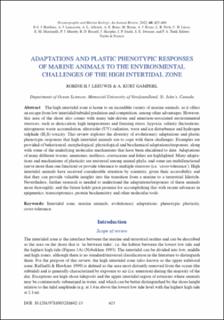Adaptations and plastic phenotypic responses of marine animals to the environmental challenges of the high intertidal zone
| dc.contributor.author | Leeuwis, Robine Helena Jannigje | |
| dc.contributor.author | Gamperl, Anthony Kurt | |
| dc.date.accessioned | 2023-02-03T08:41:24Z | |
| dc.date.available | 2023-02-03T08:41:24Z | |
| dc.date.created | 2023-01-20T11:37:09Z | |
| dc.date.issued | 2022 | |
| dc.identifier.citation | Oceanography and Marine Biology: An Annual Review. 2022, 60 625-680. | en_US |
| dc.identifier.issn | 0078-3218 | |
| dc.identifier.uri | https://hdl.handle.net/11250/3048176 | |
| dc.description.abstract | The high intertidal zone is home to an incredible variety of marine animals, as it offers an escape from low intertidal/subtidal predation and competition, among other advantages. However, this area of the shore also comes with many tide-driven and emersion-associated environmental stressors, such as desiccation, high temperatures and freezing stress, hypoxia, salinity fluctuations, nitrogenous waste accumulation, ultraviolet (UV) radiation, wave and ice disturbance and hydrogen sulphide (H2S) toxicity. This review explores the diversity of evolutionary adaptations and plastic phenotypic responses that high intertidal animals use to cope with these challenges. Examples are provided of behavioural, morphological, physiological and biochemical adaptations/responses, along with some of the underlying molecular mechanisms that have been elucidated to date. Adaptations of many different worms, anemones, molluscs, crustaceans and fishes are highlighted. Many adapta-tions and mechanisms of plasticity are universal among animal phyla, and some are multifunctional (serve more than one function) or provide tolerance to multiple stressors (i.e. ‘cross-tolerance’). High intertidal animals have received considerable attention by scientists, given their accessibility and that they can provide valuable insights into the transition from a marine to a terrestrial lifestyle. Nevertheless, further research is needed to understand the adaptations/responses of these animals more thoroughly, and the future holds great promise for accomplishing this with recent advances in epigenetics, transcriptomics, protein biochemistry and other molecular tools. | en_US |
| dc.language.iso | eng | en_US |
| dc.publisher | Informa Business | en_US |
| dc.rights | Attribution-NonCommercial-NoDerivatives 4.0 Internasjonal | * |
| dc.rights.uri | http://creativecommons.org/licenses/by-nc-nd/4.0/deed.no | * |
| dc.subject | Fenotypisk plastisitet | en_US |
| dc.subject | Phenotypic plasticity | en_US |
| dc.subject | Marin zoologi | en_US |
| dc.subject | Marine zoology | en_US |
| dc.subject | Marine naturtyper | en_US |
| dc.subject | Marine habitat types | en_US |
| dc.subject | Miljøpåvirkninger | en_US |
| dc.subject | Environmental effects | en_US |
| dc.subject | Evolusjonsbiologi | en_US |
| dc.subject | Evolutionary biology | en_US |
| dc.title | Adaptations and plastic phenotypic responses of marine animals to the environmental challenges of the high intertidal zone | en_US |
| dc.title.alternative | Adaptations and plastic phenotypic responses of marine animals to the environmental challenges of the high intertidal zone | en_US |
| dc.type | Peer reviewed | en_US |
| dc.type | Journal article | en_US |
| dc.description.version | publishedVersion | en_US |
| dc.subject.nsi | VDP::Marinbiologi: 497 | en_US |
| dc.subject.nsi | VDP::Marine biology: 497 | en_US |
| dc.subject.nsi | VDP::Marinbiologi: 497 | en_US |
| dc.subject.nsi | VDP::Marine biology: 497 | en_US |
| dc.subject.nsi | VDP::Marinbiologi: 497 | en_US |
| dc.subject.nsi | VDP::Marine biology: 497 | en_US |
| dc.source.pagenumber | 625-680 | en_US |
| dc.source.volume | 60 | en_US |
| dc.source.journal | Oceanography and Marine Biology: An Annual Review | en_US |
| dc.identifier.doi | 10.1201/9781003288602-13 | |
| dc.identifier.cristin | 2111402 | |
| cristin.ispublished | true | |
| cristin.fulltext | original | |
| cristin.qualitycode | 1 |
Tilhørende fil(er)
Denne innførselen finnes i følgende samling(er)
-
Institutt for biologi [2571]
-
Publikasjoner fra CRIStin - NTNU [38062]

